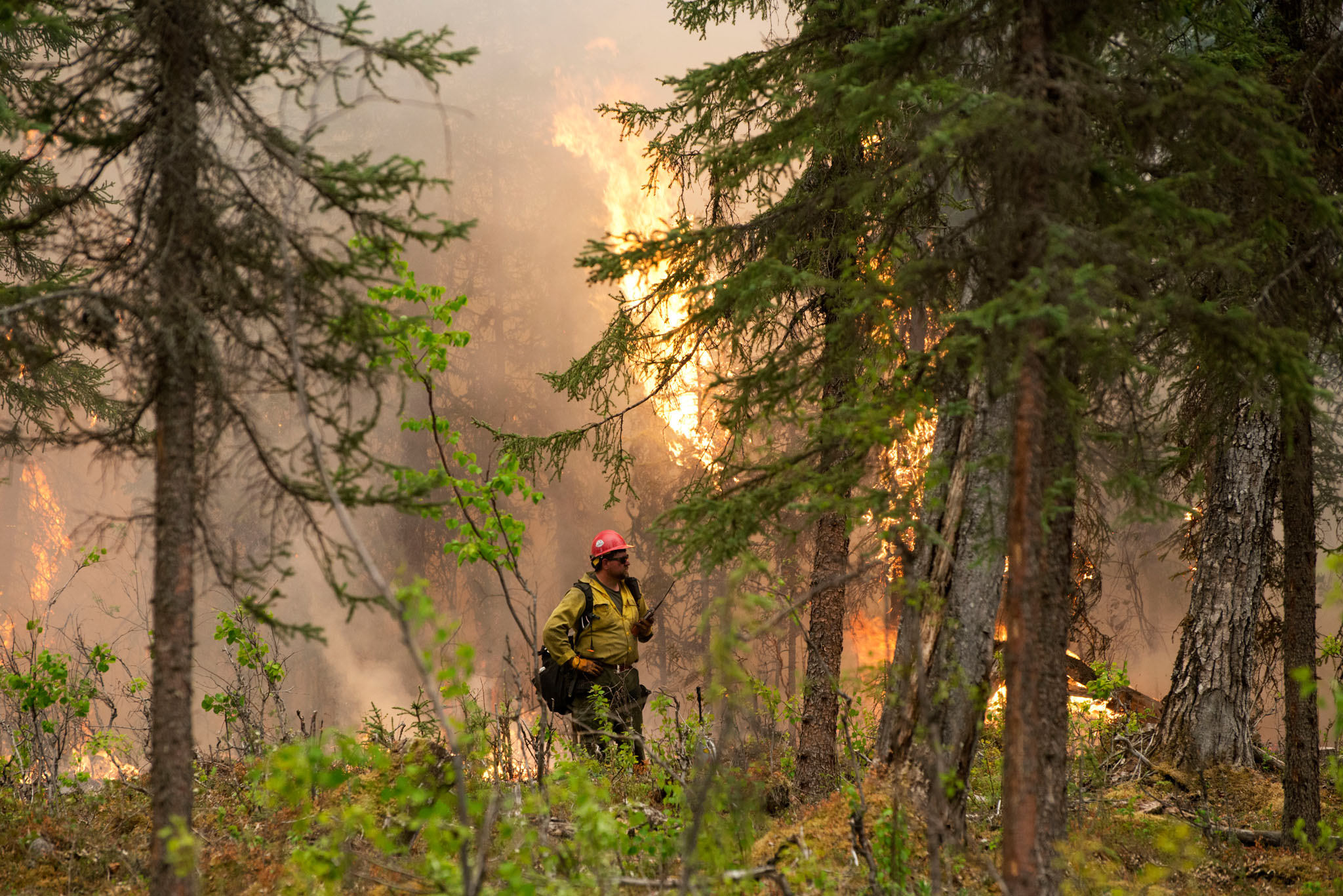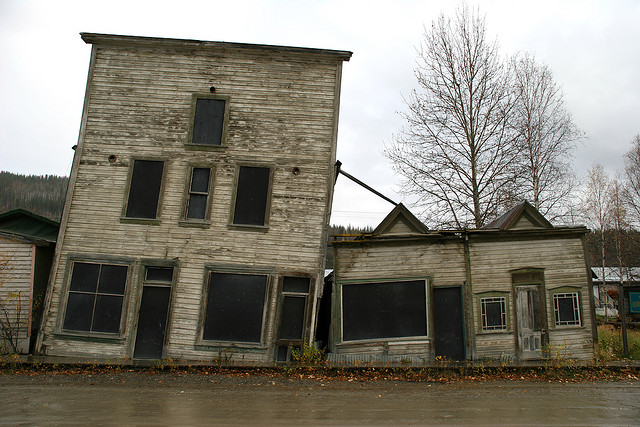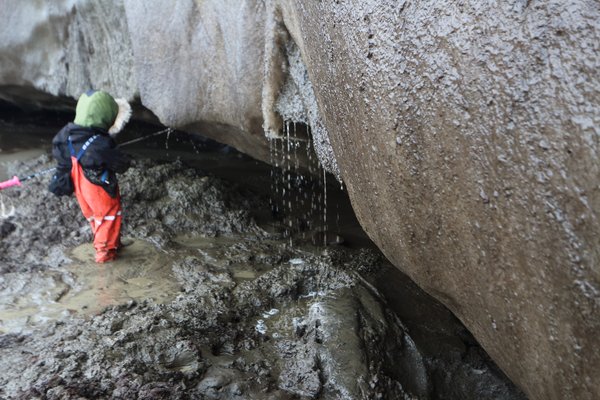
Firefighter at edge of forest and shaded fuelbreak, Alaska. © Alaska Region USFWS
Climate change is one of the most substantial and widespread environmental phenomena of our immediate future, with the effects of global climate change projected to be most severe at high latitudes. Permafrost landscapes make up a large portion of the Northern hemisphere. JEAN HOLLOWAY says understanding the impacts of change for the people, ecosystems and infrastructure in these areas is important.
JEAN HOLLOWAY is a PhD candidate in the Dept. of Geography at Ottawa University focusing on the impacts of forest fires on permafrost in the southern Northwest Territories, Canada. This article appeared in The Circle 04.15.
THERE HAS BEEN substantial winter and spring warming in west-central and northwestern Canada and virtually all of Siberia over the past three decades.
How permafrost is affected by these temperature changes depends on complex interactions among topography, surface water, soil, vegetation, and snow, which vary greatly between sites, even over short distances. Vegetation, in particular, can insulate permafrost from the atmosphere, making it resilient to increases in air temperature, at least in the short term. This ecosystem-protected permafrost covers millions of square kilometres worldwide and is particularly sensitive to climate and environmental change as it is just below 0°C, thin and usually cannot be re-established after disturbance. The most widespread source of disturbance of this permafrost is forest fire.
Forest fires are a natural and essential part of the boreal forest ecosystem, and typically locations burn every 50-300 years. Global warming and greater human activities have increased the frequency and magnitude of forest fires, which generally occur in warm and dry summers. The number of recorded forest fires in Canada has increased substantially in the last 30 years. In Siberia 1.5% of the total forested area burns annually. The response of permafrost to forest fires depends on the degree to which the permafrost is protected by the ecosystem.
The heat from the fire itself does not directly affect permafrost. The damage occurs when intense fires destroy the organic layer that is insulating the ground. This exposes the underlying mineral soil, which is more conductive than the surface organic mat, and allows more heat to get into the ground. Similarly, fire removes trees, which catch snow thus creating a deeper layer of snow that shields the ground from necessary cold winter temperatures. The active layer deepens until the upper layers of permafrost begin to thaw. Other factors that aid in this degradation include decreasing albedo due to surface darkening, and loss of shading from the tree canopy. Soils with permafrost in the coldest and wettest landscape positions (e.g. valleys) usually do not thaw as deeply after fires as soils in warmer and drier positions, such as hilltops or south-facing slopes. Fire severity is also significant, especially the degree to which the ground surface layer is burned. Complete destruction of the forest and the surface organic layer by hot, slow-moving fires will have the greatest impact, while fast-moving fires may skip over patches of forest, and low intensity fires can leave much of the organic layer intact. While the general influence on permafrost is therefore clear, how it will respond at a particular site depends on numerous local factors.
Thaw and degradation of burned areas is expected to continue until sufficient re-vegetation occurs to reestablish the insulating organic mat.
Vegetation recovery after forest fires has a major influence on stabilization of permafrost thaw. Growth is rapid in the first few years, and then slows down with time, as there is more competition for moisture and sunlight. The complete recovery of the ecosystem to pre-burn conditions can take up to 50 years. However, this depends on the climate still being suitable for permafrost. If the permafrost is ecosystem-protected and the climate is warming, permafrost degradation may continue until it disappears entirely.
Forest fires also affect permafrost landscapes in ways that are more noticeable. In the first and second years after a fire, landslides can occur on hill-slopes. Progressive uneven surface subsidence of the ground (called thermokarst) may also occur for years because of melting ground ice within the permafrost. This can affect current infrastructure as well as future development, especially as the frequency of fire means that many developments in the boreal forest may expect to be affected by fire at some point during the lifespan of infrastructure.
Another important effect of forest fires is carbon release during the fires and from thaw of permafrost post-fire. Boreal permafrost soils store large amounts of organic carbon, and fire disturbance influences the amount and type of carbon in the soil. Forest fires release approximately 53 million tonnes of carbon from North American boreal forests each year. Vegetation re-growth post-fire actually ends up storing large amounts of carbon, but in a warming climate with a higher frequency and magnitude of forest fires, this is expected to change. Furthermore, thaw of permafrost following forest fires allows carbon that has been trapped in frozen soils to become available for decomposition by soil microbes. Both these phenomena create a positive-feedback loop: climate change results in a greater frequency and magnitude of forest fires, which release greenhouse gases into the atmosphere, which results in more climate change, and so on.
How permafrost responds to forest fire is a complex issue, but it is clear that a warming climate and the expected increase in the frequency and magnitude of fires will have a substantial impact on permafrost thaw and degradation, especially in the discontinuous zone. It is important that we understand these impacts so we can make informed decisions on fire-management and how to deal with post-fire issues such as landslides and positive feedback adding to climate change.





